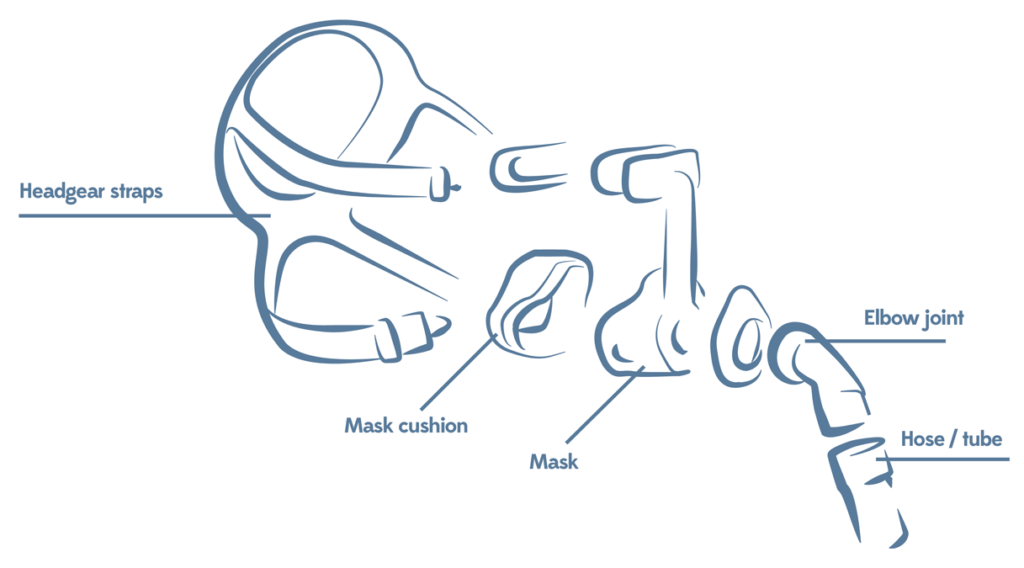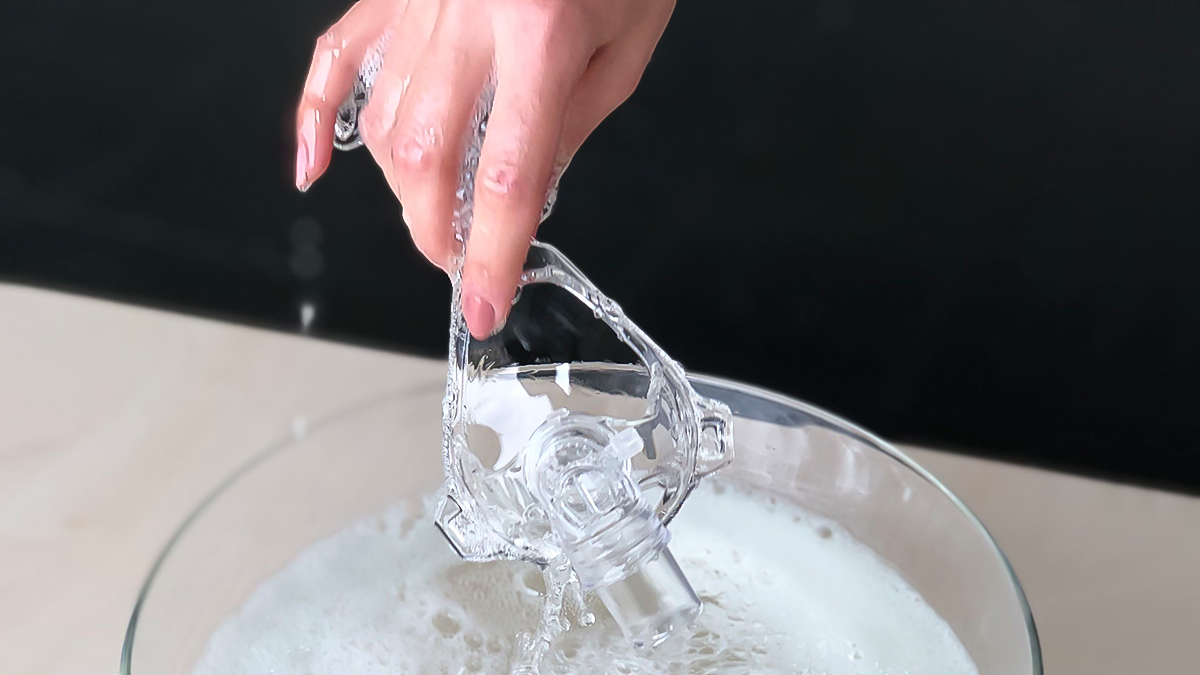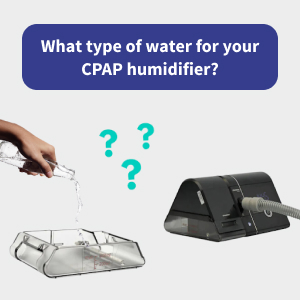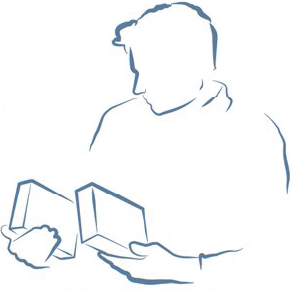Keeping your CPAP mask and your CPAP device hygienically clean is absolutely essential!
That’s because dirt and impurities on your CPAP mask or your CPAP machine are a frequent cause of unwanted side effects. Keeping them clean should therefore be part of your routine – although not everything needs to be cleaned daily. Here we show you exactly what you need to clean and when.
Why You Should Clean Your CPAP Mask, CPAP Hose, and CPAP Machine
The most important thing of all is cleaning the mask:
- Residues on the mask cushion can cause irritation, redness, or blisters in areas where the edges come into contact with your skin.
- On top of this, they can cause the mask to leak. This can happen when residues on the mask lead to the edge of the mask no longer forming a seal with the skin.
Additional benefits of cleaning the mask:
- You can significantly extend the life of the mask (whereas impurities can considerably reduce the lifespan of your mask, as they may cause the mask cushion to become brittle).
Your CPAP device and your CPAP hose / tube need regular cleaning too – which is why the humidifier should be cleaned and the filter replaced on a regular basis. Otherwise, your CPAP machine can become a breeding ground for bacteria and may no longer work properly as a result.
At a Glance: Cleaning and Maintenance of Your CPAP Equipment
You want quick information on which CPAP part you should clean (or replace) and when? You’ve come to the right place – here’s our overview summary on cleaning your CPAP equipment:
Here Are the Best Ways to Clean Your CPAP Mask – Our Recommendations
The following are proven to be effective for cleaning your CPAP mask:
Special mask cleaning wipes are very effective and are also available in a range of different scents (e.g. citrus). The moist wipes are disposable and can be thrown away after use.
Another option is to clean the CPAP mask in hot soapy water. For this you can use normal soap or a mild washing up liquid. If you prefer a really thorough clean, we recommend using a special CPAP cleaner (e.g. such as WILAsil or Löwosan). Whatever you decide to use, avoid aggressive agents containing ingredients such as alcohol or acids (distilled vinegar, for example). This will damage the mask material.
Please note:
If you’re washing the mask in soapy water, use a plastic bowl or bucket that you will only use for that purpose. We would discourage you from using a wash basin or kitchen sink. This is because these areas are often not hygienic and may contain bacteria-laden residues (e.g. from food).
Here’s the best way to clean your CPAP mask
As a rule, you should clean your mask every morning after use. This is true for the mask cushion in particular, as it comes into direct contact with the skin. Just give it a clean with a CPAP mask wipe (alcohol free) or alternatively in a bowl of hot soapy water.
Once a week you should then carry out an intensive clean. For this, the individual mask parts should be taken apart and cleaned thoroughly. It’s also recommended that you give the mask a thorough clean before the first use. There may be residues on the mask or it may have an unpleasant odour.
To clean the mask with water, run warm water into a bucket or bowl and then add a little soap.
For an intensive clean, separate out the various parts of the mask. Depending on the model, you’ll likely then have several individual parts that need to be thoroughly cleaned in the soapy water. The headgear in particular does not need to be washed daily (weekly cleaning is enough) and this can therefore be removed during the daily clean.

- Immerse the individual parts of the mask in the water and clean them thoroughly by hand.
- Afterwards, rinse each individual mask part with clear water to avoid residues of soap.
- Lay out a clean dry towel next to the bucket or bowl, where you can then leave the parts to dry out. By the evening they should be dry. Drying them in the sun is not recommended, as this can result in the mask material becoming brittle. Another option is to dry the parts with a towel.
- You can then reassemble the mask and it’s ready for nighttime.
As you can see, cleaning the mask only takes a few minutes – but makes a big difference! Incidentally, there are various CPAP masks available for different needs, and their materials and designs can also affect the cleaning routine.
Here’s the Quick Way to Clean Your CPAP Hose
You can clean your CPAP hose (aka tube/tubing) using hot soapy water. A mild washing up liquid or a special CPAP cleaner can be used for this. Some people recommend using a vinegar solution of ⅓ distilled vinegar to ⅔ tap water as an alternative. However, this is not something we advise, as this type of solution can corrode the rubber material of the hose connections.
You might find a special CPAP cleaning brush helpful for cleaning the hose. These come with an especially long brush shaft and bristles tailored to the diameter of your CPAP hose. This means you can insert the brush deep into the CPAP tubing and clean the hose really thoroughly from the inside.
How to Keep Your CPAP Machine Hygienically Clean
In order to clean your CPAP machine, we advise the following:
- The humidifier chamber of your CPAP machine should be cleaned daily under running water. We only consider it necessary to use pre-boiled or distilled water in special circumstances (e.g. compromised immune system, dubious tap water quality, particularly hard water).
- Your humidifier chamber’s weekly clean is particularly useful for removing limescale. A vinegar solution can be used for this (⅓ distilled vinegar, ⅔ tap water or boiled / distilled water). Leave the humidifier chamber to soak in the vinegar solution for around 30 minutes, then clean with a brush and rinse under running water. You’ve got two cleaning options here: you can either clean the humidifier chamber using a special descaler or run it through the dishwasher (if approved by the manufacturer).
- In addition, you should change the filters for the unit as often as advised by the manufacturer. As a rule, fine filters should be changed once a month, coarse filters once every six months. Coarse filters should also be washed on a regular weekly basis. Fine filters or hypoallergenic filters, on the other hand, have a completely different mesh structure and should never be washed.
- When cleaning your CPAP device, also ensure you always follow the instructions given by the operating manual for your device. This particularly holds true if you’re looking to disinfect your CPAP machine using ozone. You should clarify beforehand if this is approved by the manufacturer. This is because with some appliances there can be a risk of the delicate plastic or other synthetic parts being corroded by the ozone.
What type of water for your CPAP humidifier?
Do I really need to use expensive speciality water?” This is one of the most frequent questions from our customers about CPAP humidifiers. The good news: No, you don’t.
This unique CPAP mask test compares the most popular masks on the market
The most important purchasing criterion for mask wearers; comfort, freedom of movement and far more, coherently summarised especially for you.
CPAP Masks – How to Find the Right One?
What should I look out for? Learn here why CPAP masks play a central role for the patient in their acceptance of CPAP therapy.

Managing Director
Hannes Wakonig comes out of the Marketing and Finance branch and has previously worked in the field of medical technology. He is the co-founder and managing director of SomniShop (health.On Ventures GmbH) and AescuBrands.











 Welcome to SomniShop
Welcome to SomniShop